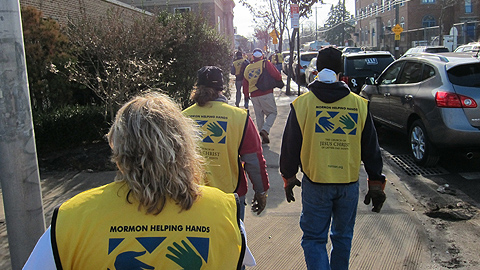Preparation
Activities performed in advance for better response:
1. Encourage individual and family preparedness (Handbook 1, 5.1.3; 5.2.11).
- Prepare a family emergency plan, emergency kits, three-month food supplies, long-term food supplies and safety items.
- Prepare financially, including obtaining insurance.
2. Encourage missions, stakes, and wards to prepare emergency response plans.
- Create an emergency communications plan (For more information about emergency communications, visit the Frequently Asked Questions page).
- Visit the Church Emergency Preparedness page.
3. Keep contact information current for the following:
- Area, mission, and stake leaders
- Church departments
- Ward members
4. Participate in emergency preparation efforts with government and other emergency response organizations.
Response
Activities that address the short-term, direct effects of a disaster:
1. Take care of your family first.
2. Follow the instructions of government leaders for evacuations and other emergency orders.
3. Respond to needs (especially people with special needs and first responders in the community).
- Bishops should apply welfare principles in ministering to members.
- Church members should be encouraged to assist neighbors with immediate needs and inform Church leaders of additional needs.
4. Assess the impact of the disaster, and report your assessment to your ecclesiastical leader and the area welfare manager (see Disaster Update Form, Emergency Response Communication Protocol)
- Full-time missionaries—Are they safe and accounted for?
- Church members—How many injuries or deaths? How many member homes are damaged or destroyed?
- Church buildings—What kind of damage has been sustained?
- Community—What are the overall effects on the community, including the infrastructure (power, water supplies, communications, and so on)?
- Anticipated needs—Is there a need for volunteer assistance from other wards and stakes or materials or other support from Church headquarters?
5. Establish communications.
- Establish a schedule for communications (mass texts, email, or conference calls).
- Determine how local Church leaders and other members will receive information about Church response efforts.
- Activate emergency communications if necessary (see Emergency Communication Planning/Emergency Communication Specialist Guidelines).
6. Determine if an emergency operations center is needed (may consult with Church headquarters).
7. Organize work crews for disaster cleanup, and involve other stakes as needed (see Emergency Response Organization).
8. Consider using Church meetinghouses for the response (see Emergency Response Resources, Shelter Agreement with the Red Cross, and Temporary Use Agreement).
9. Determine whether help from Church headquarters is needed.
10. Manage offers of help from others, such as government agencies and other emergency response organizations.
11. Keep the media informed of the Church’s response (see Handbook 1, 5.1.3; Community Interaction)
12. Respond to community requests for Church assistance with volunteers, and recommend approval of commodities or cash for community organizations (see Community Interaction, Humanitarian Request Form).
13. Ensure that all requests for reimbursement for local expenses are submitted to Church headquarters (see Emergency Response Resources, MLS Instructions).
Recovery
Longer-term activities that help restore the community:
1. Follow welfare principles in ministering to members with long-term needs, and inform them of available community recovery resources.
2. Inform local Church leaders and members about community volunteer opportunities.
Mitigation
Activities designed to improve future responses:
1. Review results from the recent emergency event, and record lessons learned.
2. Update emergency response plans based on lessons learned.
